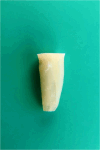Evaluation of apically extruded debris during root canal filling material removal in teeth with external apical root resorption: a comparison of different obturation techniques
- PMID: 39261778
- PMCID: PMC11391590
- DOI: 10.1186/s12903-024-04833-2
Evaluation of apically extruded debris during root canal filling material removal in teeth with external apical root resorption: a comparison of different obturation techniques
Abstract
Background: Root canal retreatment is necessary when initial treatment fails. Nickel-titanium systems help remove filling materials; however, some methods can cause canal content extrusion, resulting in inflammation and delayed healing. This study aimed to examine the impact of different preparation techniques and endodontic file systems on apical debris volume to limit material dispersion to periradicular tissues.
Methods: Ninety extracted maxillary incisors were evaluated. Simulated apical root resorption was created by removing the apical 2 mm of the root. The teeth were divided into two groups: one filled with a single cone and the other with cold lateral compaction (CLC). Each group was further divided into three subgroups (n = 15 each): Subgroup 1 used Reciproc R25 for removal and R50 for final preparation; Subgroup 2 used ProTaper Universal Retreatment (PTUR) files D1, D2, and D3 for removal and ProTaper Next X5 for finalization; and Subgroup 3 used VDW.Rotate Retreatment (VDW.RotateR) for removal and VDW.Rotate 50.04 for completion. Debris from retreatment was collected in pre-weighed tubes to determine the amount. The apical extrusion data underwent a two-way analysis of variance.
Results: The Reciproc group had a mean extruded debris weight of 0.54 ± 0.24 mg, higher than the PTUR (0.28 ± 0.15 mg) and VDW.RotateR (0.39 ± 0.29 mg) groups (p < 0.05). The single-cone technique (SCT) resulted in a mean debris weight of 0.34 ± 0.23 mg, lower than the CLC technique, which had a mean of 0.46 ± 0.27 mg (p < 0.05). SCT had a shorter retreatment duration (111.12 ± 33.46 s) compared to CLC (176.26 ± 52.26 s) (p < 0.05).
Conclusion: The Reciproc file system and the CLC obturation technique resulted in greater apical debris extrusion than the other methods. SCT was quicker than CLC. The Reciproc groups are more susceptible to apex extrusion during retreatment.
Keywords: Apical debris extrusion; Endodontic; PTUR; Reciproc; Retreatment; Simulated apical root resorption; VDW.rotateR.
© 2024. The Author(s).
Conflict of interest statement
The authors declare no competing interests.
Figures




Similar articles
-
Evaluation of apically extruded debris during the removal of canal filling material using three different Ni-Ti systems and hand files in teeth with simulated apical root resorption.Int Endod J. 2020 Mar;53(3):403-409. doi: 10.1111/iej.13234. Epub 2019 Nov 3. Int Endod J. 2020. PMID: 31605377
-
Evaluation of apically extruded debris during root canal retreatment with several NiTi systems.Int Endod J. 2015 Dec;48(12):1194-8. doi: 10.1111/iej.12425. Epub 2015 Jan 19. Int Endod J. 2015. PMID: 25557631
-
Evaluation of debris extruded apically during the removal of root canal filling material using ProTaper, D-RaCe, and R-Endo rotary nickel-titanium retreatment instruments and hand files.J Endod. 2014 Dec;40(12):2066-9. doi: 10.1016/j.joen.2014.09.004. Epub 2014 Oct 16. J Endod. 2014. PMID: 25443282
-
In vitro evaluation of filling material removal and apical debris extrusion after retreatment using Reciproc blue, Hyflex EDM and ProTaper retreatment files.BMC Oral Health. 2023 Nov 21;23(1):902. doi: 10.1186/s12903-023-03579-7. BMC Oral Health. 2023. PMID: 37990209 Free PMC article.
-
Endodontic retreatment efficacy with and without solvents: A systematic review.J Conserv Dent Endod. 2023 Nov-Dec;26(6):610-615. doi: 10.4103/JCDE.JCDE_86_23. Epub 2023 Nov 22. J Conserv Dent Endod. 2023. PMID: 38292751 Free PMC article. Review.
Cited by
-
Quantitative Assessment of Apically Extruded Debris During Retreatment Procedures Using Three Nickel-Titanium Rotary Systems: An In Vitro Comparative Study.Dent J (Basel). 2024 Nov 26;12(12):384. doi: 10.3390/dj12120384. Dent J (Basel). 2024. PMID: 39727441 Free PMC article.
References
Publication types
MeSH terms
Substances
Grants and funding
LinkOut - more resources
Full Text Sources
Miscellaneous

